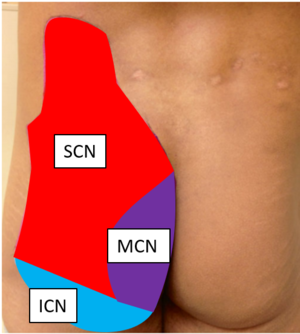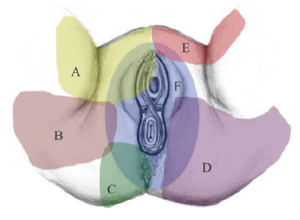Inferior Cluneal Nerve Entrapment
The cluneal nerves are a group of pure sensory nerves (superior, medial or middle, and inferior) that provide sensory supply to the buttocks. This article covers inferior cluneal nerve entrapment. See also the more common superior cluneal nerve entrapment, as well as middle cluneal nerve entrapment.
Anatomy

The cluneal nerves are divided into the superior cluneal nerve (SCN), middle cluneal nerve (MCN), and inferior cluneal nerve (ICN).

Copyright Andrea Trescot[1]
The inferior cluneal nerves (ICN) arise from the posterior femoral cutaneous nerve of the thigh (PFCN), which in turn is derived from the sensory branches of S1-3. The PFCN travels with the sciatic and pudendal nerves and passes through the sciatic notch. In the subgluteal region it ramifies into the inferior cluneal and perineal branches. The nerves have a recurrent course around the inferior margin of gluteus maximus. It innervates the inferior region of the buttocks, lateral anal region (but not the anus itself), and lateral labia majora (but not labia minora or vagina).[1]
Pathophysiology
Entrapment occurs with sitting and the site can be at the inferior margin of the ischium or at the level of the sciatic spine and piriformis.[1]
Epidemiology
The epidemiology is unknown.
Clinical Features
The patient may report a history of a fall onto their buttocks. Sitting, especially on hard seats, may cause symptoms. Examine for deep tenderness along the inferior edge of the gluteus maximus between the ischium and greater trochanter. Look for hyperaesthesia with pin prick and decreased light touch sensation over the inferior buttocks. [1]
Diagnosis
There is are no agreed diagnostic criteria.
Treatment
Injections can be done.[1]
References
Literature Review
- Reviews from the last 7 years: review articles, free review articles, systematic reviews, meta-analyses, NCBI Bookshelf
- Articles from all years: PubMed search, Google Scholar search.
- TRIP Database: clinical publications about evidence-based medicine.
- Other Wikis: Radiopaedia, Wikipedia Search, Wikipedia I Feel Lucky, Orthobullets,


